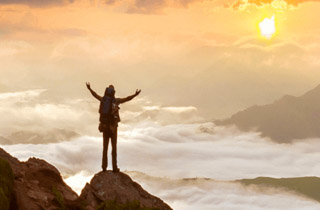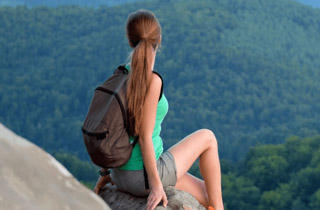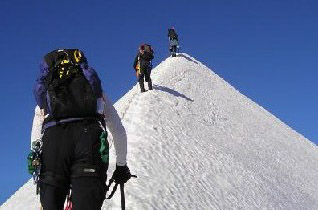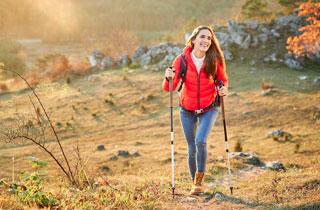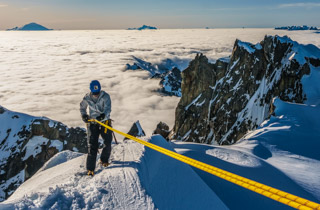Coping with Altitude
Coping with Altitude
Ten Ways to Manage Effects of Altitude
If you intend to climb, trek, scramble, ski, or hike above 7,000′ elevation soon, you may be wondering how your body will handle the reduced atmospheric pressure and hence the feeling of less oxygen when you are at altitude. Below are our favorite Top Ten Tips that have worked for us and clients on Adams, Rainier, Baker, Kilimanjaro, Denali, Aconcagua, and other high-altitude peaks. By knowing what has worked for others you can arm yourself with tricks to try to prevent altitude sickness or cope with it once you start experiencing the onset of symptoms of AMS (Acute Mountain Sickness.)
Hydration
Always stay thoroughly hydrated on any hike, particularly those involving travel above 7,000′ elevation. Keep urine colorless and drink before you get thirsty, as thirst usually occurs only after you are already dehydrated. This means try to drink at least 6-8 ounces every 30-45 minutes on hot summer days when you are going uphill carrying a heavy pack. Camelback hydration systems can be helpful in always having a water source nearby, but you can also clip Nalgene water bottles to a shoulder strap so you can grab a drink without having to stop and dig into your pack. At elevations above 10,000′ be sure to have an insulating tube to protect the Camelback from freezing, and carry a spare empty Nalgene in case your system freezes, so you still have access to a beverage.
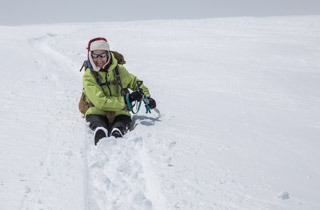

Thermoregulation
Keep watch on your body’s core temperature as extreme perspiration can sap your energy faster than you realize. When climbing something like Mt. Rainier where there is snow readily available, try wrapping some in a bandana and applying the compress frequently to your forehead to help you cool down; if you carry extra water, a little on your forehead (or from streams as you encounter them) can feel especially refreshing. Be sure to wear light-colored (beige, gray, or white) clothing in hot summer months and darker colors (blue or black) in cold months to absorb or repel sunlight. Dress in layers so you can discard or add clothing to stay comfortable as you hike.
Eat regularly
Whether you feel like it or not, you must keep eating. Your body works hard to go uphill and carry extra weight; if you are traveling at altitude the stresses on your body are even greater and you probably will feel less interested in food. Be sure to test snack and meal food ahead of time at sea level and only take with you whatever is palatable and satisfying down low, minus spicy or hard-to-chew foods. Include carbohydrate solutions to add to your beverages such as Powerade, Cytomax, or Gatorade. Have some hard candy, jelly beans, lemon drops, or Gu packets handy so you have ready access to your main fuel source: carbohydrates.
Pressure Breathing
Learn how you can use and benefit from this technique any time you start to feel a bit nauseous above about 7,500 feet. Since the atmospheric pressure changes the higher you go, it becomes increasingly difficult to get the oxygen you need into your lungs. By pursing your lips and exhaling forcefully and fully, you let the carbon dioxide in your lungs escape, allowing for a more ready exchange with oxygen in the ‘thinner air.” At the first sign of nausea, take some water, switch to pressure breathing for a few paces, and incorporate the Rest Step (see below) and you will in all likelihood start to feel a lot better.
Rest Step
Anytime you start to feel a bit nauseous, you may want to transition into the ‘rest step’, a method of hiking that allows the skeleton to take the brunt of the weight rather than the muscles. Lock out the bottom leg as you shift one leg uphill, pause in a full rest position, then transfer the weight to the other leg, lock out the new bottom leg, and pause. In this way, you avoid the ‘hurry and wait’ gait of inexperienced climbers and find a comfortable rhythm that you can sustain indefinitely.
Slow your pace
To enable you to continue steadily, listen carefully to your body and be sure to start a little slower than you normally go to warm up well and hit your stride. If you try to push it to keep up with the fastest member of your party you may not make it to your goal. In the case of altitude climbing, the tortoise usually outpaces the hare in the long run, but the key is to go at a slow and steady pace that enables you to go continuously with very few rest stops.
Acclimatize
Plan to spend an extra day or night above 5000′ if you can. On a climb of Mt. Rainier, for example, staying at the lodge at Paradise or camping in the basin on the way up to Camp Schurman can help enormously with acclimatization. Instead of racing up to 9,500 (Camp Schurman) or 10,150 (Camp Muir) on day one and trying to summit the very next day, allowing yourself three days for the trip makes it far more enjoyable.
Medications
Aspirin or Tylenol
Please note that this page is not meant to provide medical advice, and you should always consult your physician before embarking on any strenuous training regimen. However, many climbers have found that at the onset of their high-altitude climbs, taking some aspirin or other pain-relief medication as a preventative measure against headaches can be beneficial.
Altitude medicines
As a last resort, if you have had trouble at altitude in the past or wish to be prepared for any scenario, talk to your physician about a prescription for appropriate high-altitude medications (such as Diamox). Gingko Biloba is a supplement that some people have found to be effective as well.
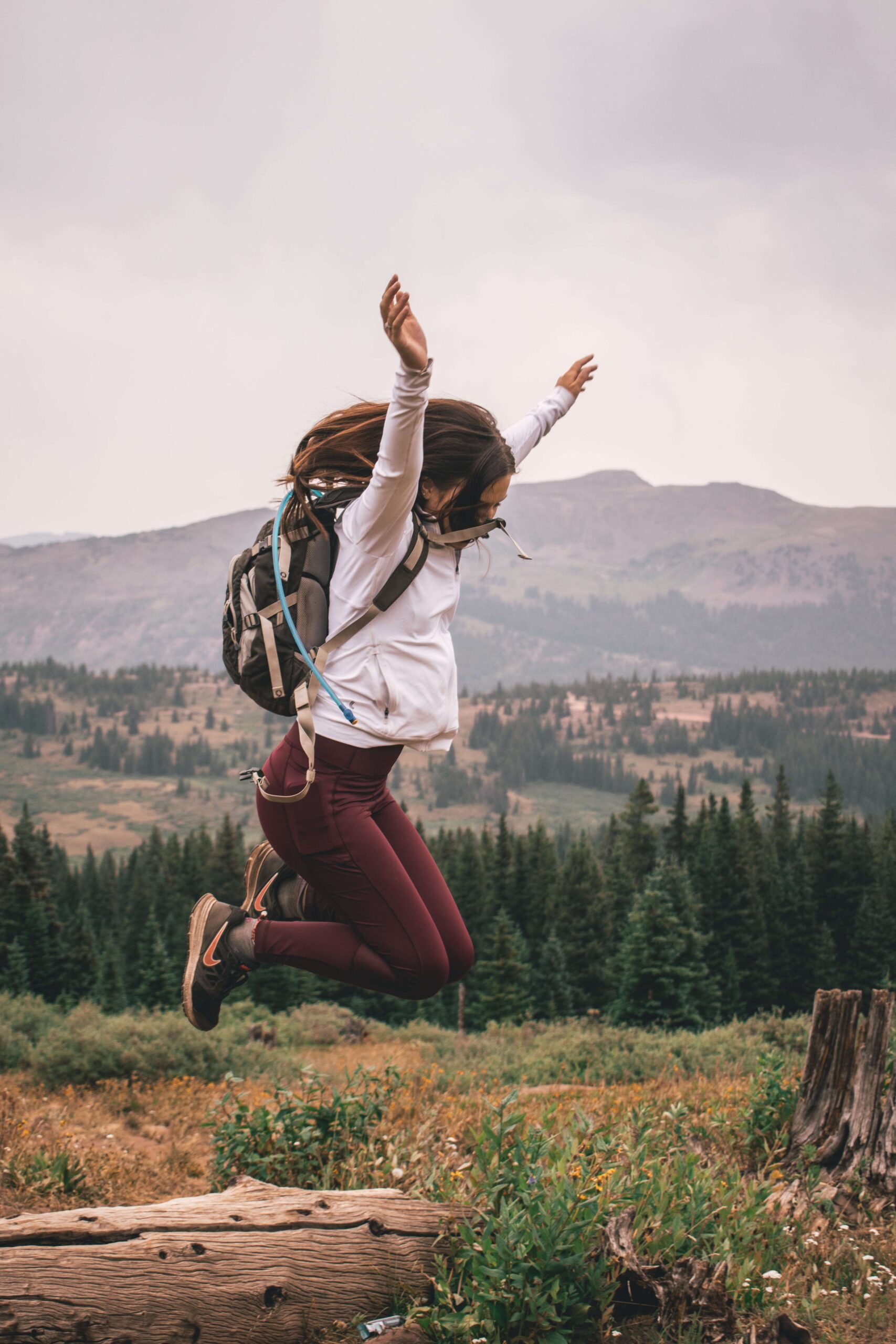
Proper Conditioning
Above all else, the one element you have complete control over is how prepared you are physically. Include interval training, appropriate over-weight pack hiking that involves back-to-back training, and strength training in your conditioning program.
If you are concerned about the effects of altitude and would like professional guidance on preparation, contact one of our alpine coaches to collaborate on developing a suitable, safe, and effective program.

